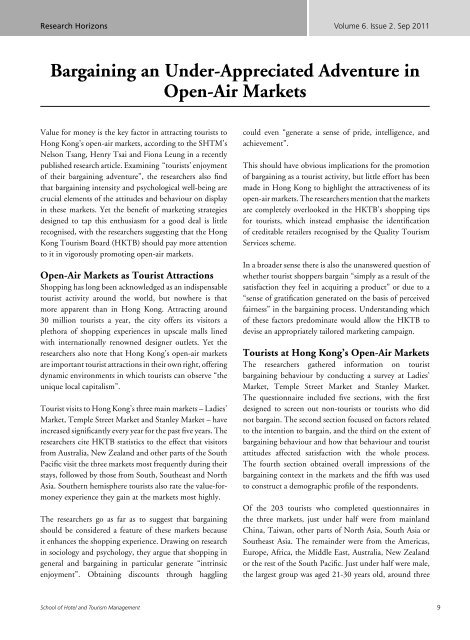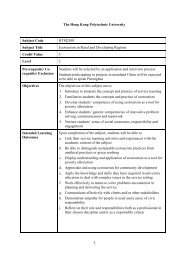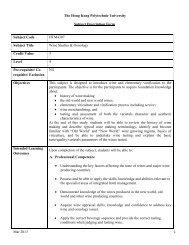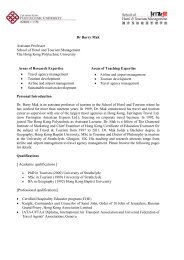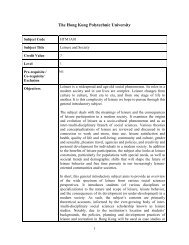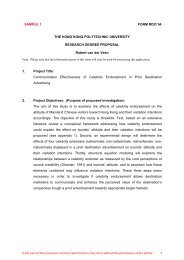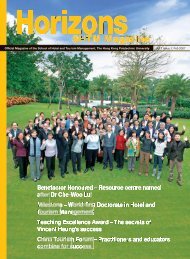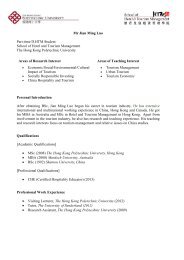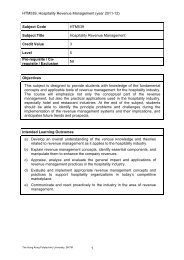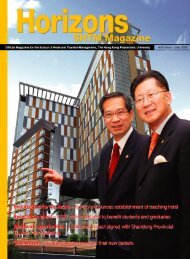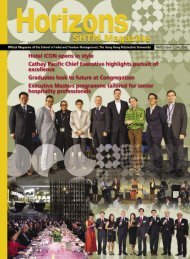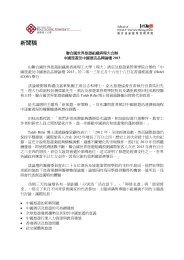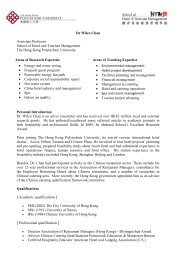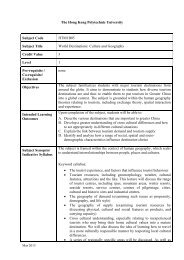Vol 11 Issue 2, September 2011 - School of Hotel & Tourism ...
Vol 11 Issue 2, September 2011 - School of Hotel & Tourism ...
Vol 11 Issue 2, September 2011 - School of Hotel & Tourism ...
You also want an ePaper? Increase the reach of your titles
YUMPU automatically turns print PDFs into web optimized ePapers that Google loves.
Research Horizons <strong>Vol</strong>ume 6. <strong>Issue</strong> 2. Sep 20<strong>11</strong>Bargaining an Under-Appreciated Adventure inOpen-Air MarketsValue for money is the key factor in attracting tourists toHong Kong’s open-air markets, according to the SHTM’sNelson Tsang, Henry Tsai and Fiona Leung in a recentlypublished research article. Examining “tourists’ enjoyment<strong>of</strong> their bargaining adventure”, the researchers also findthat bargaining intensity and psychological well-being arecrucial elements <strong>of</strong> the attitudes and behaviour on displayin these markets. Yet the benefit <strong>of</strong> marketing strategiesdesigned to tap this enthusiasm for a good deal is littlerecognised, with the researchers suggesting that the HongKong <strong>Tourism</strong> Board (HKTB) should pay more attentionto it in vigorously promoting open-air markets.Open-Air Markets as Tourist AttractionsShopping has long been acknowledged as an indispensabletourist activity around the world, but nowhere is thatmore apparent than in Hong Kong. Attracting around30 million tourists a year, the city <strong>of</strong>fers its visitors aplethora <strong>of</strong> shopping experiences in upscale malls linedwith internationally renowned designer outlets. Yet theresearchers also note that Hong Kong’s open-air marketsare important tourist attractions in their own right, <strong>of</strong>feringdynamic environments in which tourists can observe “theunique local capitalism”.Tourist visits to Hong Kong’s three main markets – Ladies’Market, Temple Street Market and Stanley Market – haveincreased significantly every year for the past five years. Theresearchers cite HKTB statistics to the effect that visitorsfrom Australia, New Zealand and other parts <strong>of</strong> the SouthPacific visit the three markets most frequently during theirstays, followed by those from South, Southeast and NorthAsia. Southern hemisphere tourists also rate the value-formoneyexperience they gain at the markets most highly.The researchers go as far as to suggest that bargainingshould be considered a feature <strong>of</strong> these markets becauseit enhances the shopping experience. Drawing on researchin sociology and psychology, they argue that shopping ingeneral and bargaining in particular generate “intrinsicenjoyment”. Obtaining discounts through hagglingcould even “generate a sense <strong>of</strong> pride, intelligence, andachievement”.This should have obvious implications for the promotion<strong>of</strong> bargaining as a tourist activity, but little effort has beenmade in Hong Kong to highlight the attractiveness <strong>of</strong> itsopen-air markets. The researchers mention that the marketsare completely overlooked in the HKTB’s shopping tipsfor tourists, which instead emphasise the identification<strong>of</strong> creditable retailers recognised by the Quality <strong>Tourism</strong>Services scheme.In a broader sense there is also the unanswered question <strong>of</strong>whether tourist shoppers bargain “simply as a result <strong>of</strong> thesatisfaction they feel in acquiring a product” or due to a“sense <strong>of</strong> gratification generated on the basis <strong>of</strong> perceivedfairness” in the bargaining process. Understanding which<strong>of</strong> these factors predominate would allow the HKTB todevise an appropriately tailored marketing campaign.Tourists at Hong Kong’s Open-Air MarketsThe researchers gathered information on touristbargaining behaviour by conducting a survey at Ladies’Market, Temple Street Market and Stanley Market.The questionnaire included five sections, with the firstdesigned to screen out non-tourists or tourists who didnot bargain. The second section focused on factors relatedto the intention to bargain, and the third on the extent <strong>of</strong>bargaining behaviour and how that behaviour and touristattitudes affected satisfaction with the whole process.The fourth section obtained overall impressions <strong>of</strong> thebargaining context in the markets and the fifth was usedto construct a demographic pr<strong>of</strong>ile <strong>of</strong> the respondents.Of the 203 tourists who completed questionnaires inthe three markets, just under half were from mainlandChina, Taiwan, other parts <strong>of</strong> North Asia, South Asia orSoutheast Asia. The remainder were from the Americas,Europe, Africa, the Middle East, Australia, New Zealandor the rest <strong>of</strong> the South Pacific. Just under half were male,the largest group was aged 21-30 years old, around three<strong>School</strong> <strong>of</strong> <strong>Hotel</strong> and <strong>Tourism</strong> Management 9


